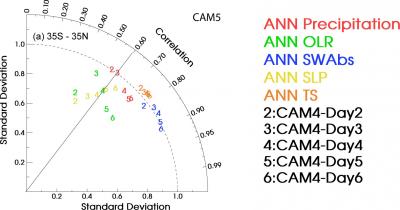Many Forecast Errors Are Climate Errors
Despite recent advances made in climate modeling, large systematic errors are still present in their simulated mean state of climate. However, fully understanding the cause of these systematic errors in a climate system is difficult because climate systems are complicated non-linear systems, and climate errors could be the compensated result from errors in representing various dynamical and physical processes. Scientists at Lawrence Livermore National Laboratory (LLNL) have used the U.S. Department of Energy (DOE) funded Cloud-Associated Parameterizations Testbed (CAPT) to systematically examine the relationship between composite errors in the short-range hindcasts and long-term climate simulations exhibited in the latest versions of Community Atmospheric Model, Version 4 (CAM4) and Version 5.1 (CAM5) with the goal to clarify over what time-scales model systematic errors develop. Such a study can provide essential clues to the origins of these errors.
Researchers examine the correspondence between forecast errors and climate errors in CAM4 and CAM5 using data from a series of 6-day hindcasts with the two models initialized every day from the European Center for Medium-Range Weather Forecasts (ECMWF) analysis and the three-year “free-running” atmosphere-only mode (AMIP) for the two Year(s) of Tropical Convection (YOTC) (May 2008-April 2010). The focus is on those well-known climate biases that are exhibited in both the CAM models and many other climate models. The analysis is based on the annual mean errors, which are constructed from the composite of Day 2 to Day 6 hindcasts and the AMIP simulations for the complete year of 2009. The systematic errors in the model-produced tropical general circulation and those moist process-related fields like surface precipitation, clouds, and radiation are examined. Errors in the surface temperature and sea-level pressure are also discussed. Both similarities and differences between hindcasts and climate integrations are of interest since the similarities may indicate errors that are directly the result of parameterization errors as the large-scale flow remains close to observed, whereas differences could reflect errors that develop once incorrect states and circulations have developed due to their poor interactions with the parameterized physics.
Most climate errors, particularly those associated with moist processes, are apparent in Day 2 hindcasts and steadily grow with the hindcast lead time. Examples are the excessive precipitation in much of the tropics and the overestimate of net shortwave absorbed radiation in the stratocumulus cloud decks over the eastern subtropical oceans and the Southern Ocean at about 60S. In contrast, other climate errors are present in the hindcasts, but with amplitudes that are significantly smaller than their climate errors. These include the cold biases in the lower stratosphere, the unrealistic double-Intertropical Convergence Zone pattern in the simulated precipitation, and an annular mode bias in extratropical sea-level pressure. This indicates that these biases take longer to develop. The hindcast approach used in CAPT helps separate errors in physics from errors in large-scale state and provides significant insight into the origin of these errors.
This work is supported by the Regional and Global Climate Modeling Program and Atmospheric System Research Program of the Office of Science at the U. S. Department of Energy. Work at LLNL was performed under the auspices of the U. S. Department of Energy, Office of Science, Office of Biological and Environmental Research by Lawrence Livermore National Laboratory under contract No. DE-AC52-07NA27344.

